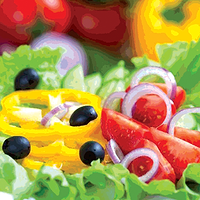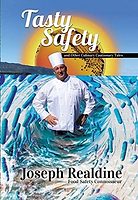The foodservice industry is extensive and provides meals to millions of people daily. Foodborne illness can be caused by contamination during food preparation and/or storage when conditions favor bacteria growth. The hazard may be in the food, in the people handling the food and/or in the environment where the food is processed.
According to Roy Costa in the Food Safety Handbook,[1] the major risk factors for foodborne illness are the following: improper cooling, lapse of 12 hours or more between preparation and service, infected food handlers, improper reheating, contaminated raw ingredients, cross contamination and inadequate cooking. This food safety assessment was designed to evaluate how culinary students rated those risk factors and their educational awareness of them.
Foodservice institutions are one of the largest single employers in the U.S., and many culinary students will become part of the more than 12 million workers in this industry. Commercial foodservice establishments are a major part of the U.S. economy and generate in excess of $1 billion per day according to the National Restaurant Association (NRA). Since the NRA estimates that over 50 billion meals are eaten in restaurants, schools and cafeterias annually, foodservice worker hygiene is of the upmost importance. Food recalls during the past several years have increased consumer awareness of bacteria contamination, as the microbe names of Salmonella, Listeria and Escherichia coli have become household scrabble words.
Foodborne disease occurrence is likely under-reported because the symptoms are often thought to be the result of a “flu” virus. Since individuals frequently engage in risky eating behaviors like consuming raw or undercooked foods,[2] the potential for foodborne illness is great. Studies have shown that food safety knowledge can be a strong predictor of poor food handling practices such as lack of foodservice experience, no food safety certification course, and minimum awareness of microbiology (viruses, fungus, bacteria) and their relationship to food.
Culinary students are being trained to add to the ever-expanding foodservice work force. A survey of culinary arts students in two programs was designed to assess knowledge of 1) maintenance of good personal hygiene, 2) keeping work areas clean and safe, 3) food handling practices like adequate cooking and holding temperatures. To assist in formatting the 25-question survey, 15 culinary students were asked what foods they regularly used in recipes that may cause food safety concerns. Sixty-nine percent personally consumed raw cookie dough while sixteen percent planned menus with raw shellfish (oysters, clams, mussels). Only five percent recommended raw ground beef (steak tartar) as an appetizer.
Study Design
Sixty-seven adults enrolled in two college culinary arts programs located in the Tampa Bay, FL area were surveyed. These students constituted a wide range of ages, 18 to 56 years old. The majority (82 percent) were males attending various culinary arts classes who considered themselves healthy and very aware of food safety issues, although 60 percent of them had limited exposure to food safety education. Fifty-two percent of those surveyed had never held a job serving or preparing food in a commercial foodservice establishment.
Criteria for inclusion in the study was participation in a nutrition course taught 2008–2009 and enrollment in at least three culinary arts classes. The survey instrument was composed of 25 questions including the importance of cleanliness, frequency of handwashing, hand sanitation techniques, food holding temperatures and use of raw foods/undercooked foods in menu planning.
Survey Results
The culinary students rated hot pads and gloves and can opener as the most important items to assess for food safety in the kitchen. Measuring spoons and saucepans rated the lowest.
When asked to rate their home kitchen cleanliness, only 50 percent rated their kitchen very good and 10 percent reported excellent.
Handwashing frequency comments varied from “too many to count” to “more than 20 times,” and 91 percent reported that the ideal handwashing temperature should be 110 to 120 °F. But what was reported on the survey and observed in practice were very different. Twenty-two culinary students were surveyed and followed into the rest rooms where they were inconspicuously observed by survey observers. Seventy-nine percent (males and females) did not wash their hands before leaving the rest room. All 22 students touched the door handles of the rest rooms with their bare hands when exiting the area.
According to the Handbook for Safe Food Service Management,[3] most microorganisms causing foodborne illness are transmitted to food on the hands of foodservice workers. Training culinary students to wash their hands and/or change gloves after any action that may cause contamination is essential- after using the toilet, smoking or eating, coughing, sneezing, touching hair or face, as well as handling raw chicken or meat.
Seventeen culinary students were observed on four occasions in smoking groups by survey observers. The purpose of these observations was to assess if handwashing followed the smoke break before returning to food preparation. Only one individual was observed washing their hands before resuming food preparation.
Gender was a significant factor in food safety knowledge among culinary students. Females who had completed a nutrition and/or microbiology course reported higher scores on food safety awareness. Three females of the 67 culinary students reported person
l experiences with “food poisoning” or food safety issues that provided first hand knowledge in detecting causes of adverse symptoms.
The age of the culinary student was a decisive factor in assessing food safety knowledge. Older students (> 30 years old) may have had previous experience from military or job training opportunities that allowed improved awareness of correct cooking temperatures, serving temperatures and handwashing techniques.
Sixty-one percent of the culinary arts students reported the refrigerator/walk-in as the recommended site for defrosting food. Use of food thermometers was reported by 92 percent of the students.
Summary
A limitation of this study is the sample size and limited geographic area. Nevertheless, these were students at two schools of culinary arts that could be preparing meals at a local restaurant in your area in the future. Culinary arts programs need to enhance safe food handling instructions beyond the basic skills of cooking.
Further study must be done to assess whether economics may be a cause for some of the culinary student mindset about not washing their hands thoroughly with soap and drying them with paper towels. Two of the students responded to survey observers that they were “saving water and money” by not washing their hands more frequently.
Betty Wedman-St Louis, Ph.D., RD, LD is a licensed nutritionist and environmental health specialist in St. Petersburg, FL.
References
1. Schmidt R.H. and G.E. Rodrick. 2003. Food safety handbook. John Wiley & Sons, NJ.
2. Byrd-Bredbenner C., V. Wheatley, D. Schaffner, C. Bruhn, L. Blalock and J. Mauer. 2007. Development and implementation of a food safety knowledge instrument. J Food Sci Edu 46–55.
3. National Assessment Institute. 1994. Handbook for safe food service management. Regents/Prentice Hall, NJ.
Beuchat L.R. and J.H. Ryee. 1997. Produce handling and processing practices. Emerging Infectious Diseases. Oct–June.
Byrd-Bredbenner C., V. Wheatley, D. Schaffner, C. Bruhn, L. Blalock and J. Mauer. 2007. Development of food safety psychosocial questionnaires for young people. J Food Sci Edu 30–37.
Campbell M.E., C.E. Gardner, J.J. Dwyer, S.M. Isaacs, P.D. Krueger and J.Y. Ying. 1998. Effectiveness of public health interventions in food safety: A systematic review. Can J Public Health May–June, 197–202.
Entis P. 2007. Food safety. ASM Press, Washington, DC.
Yang S., M.G. Leff, D. McTague, K.A. Horvath, J. Jackson-Thompson, T. Murayi, G.K. Oeselager, T.A. Melnik, M.C. Gildemaster, D.C. Ridings, S.F. Alteberuse and F.J. Angulo. 1998. Multistate surveillance for food-handling, preparartion, and consumption behaviors associated with foodborne diseases: 1995 and 1996 BRFSS food safety questions. MMWR CDC Surveill Summer 33–57.


